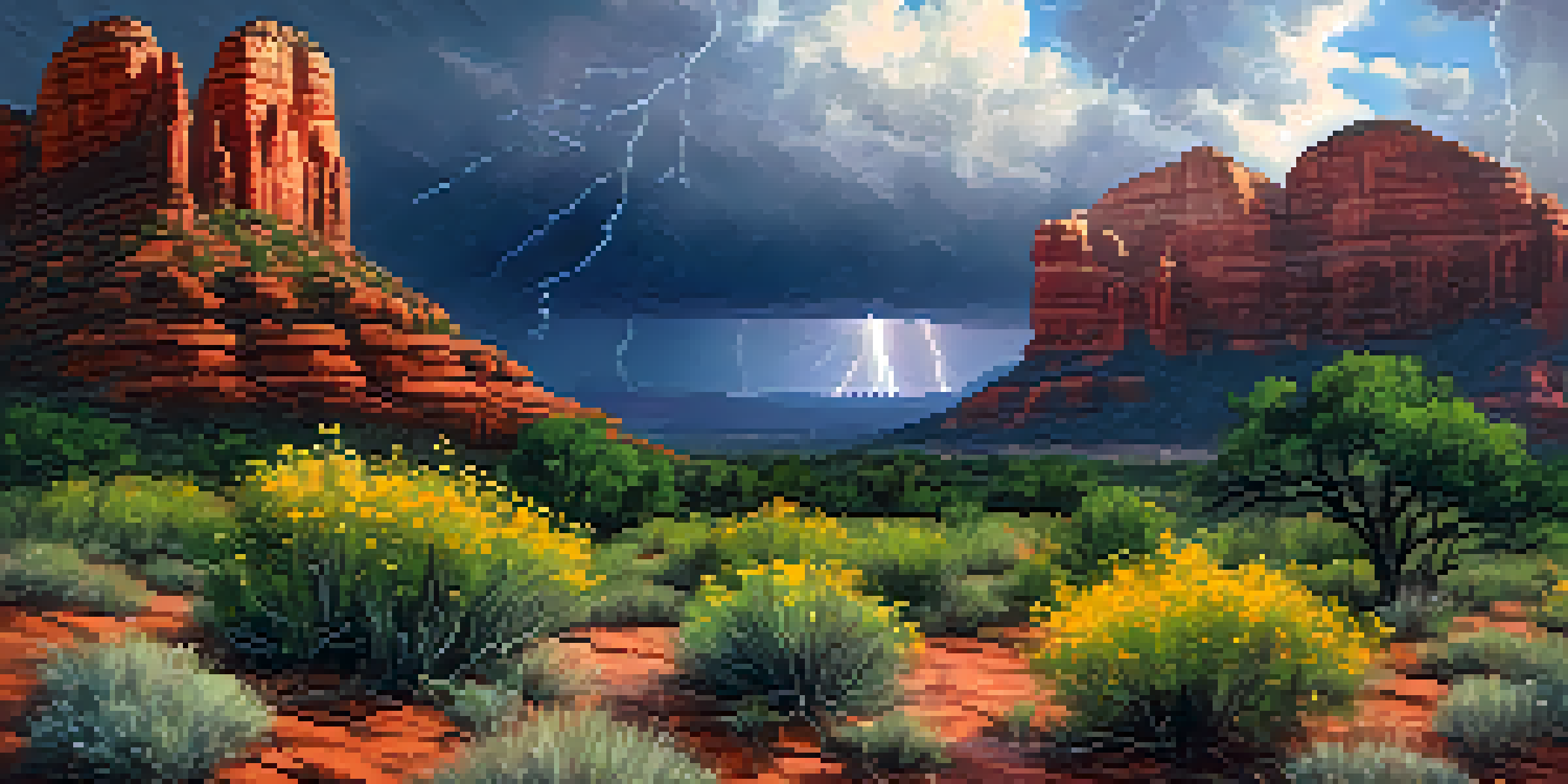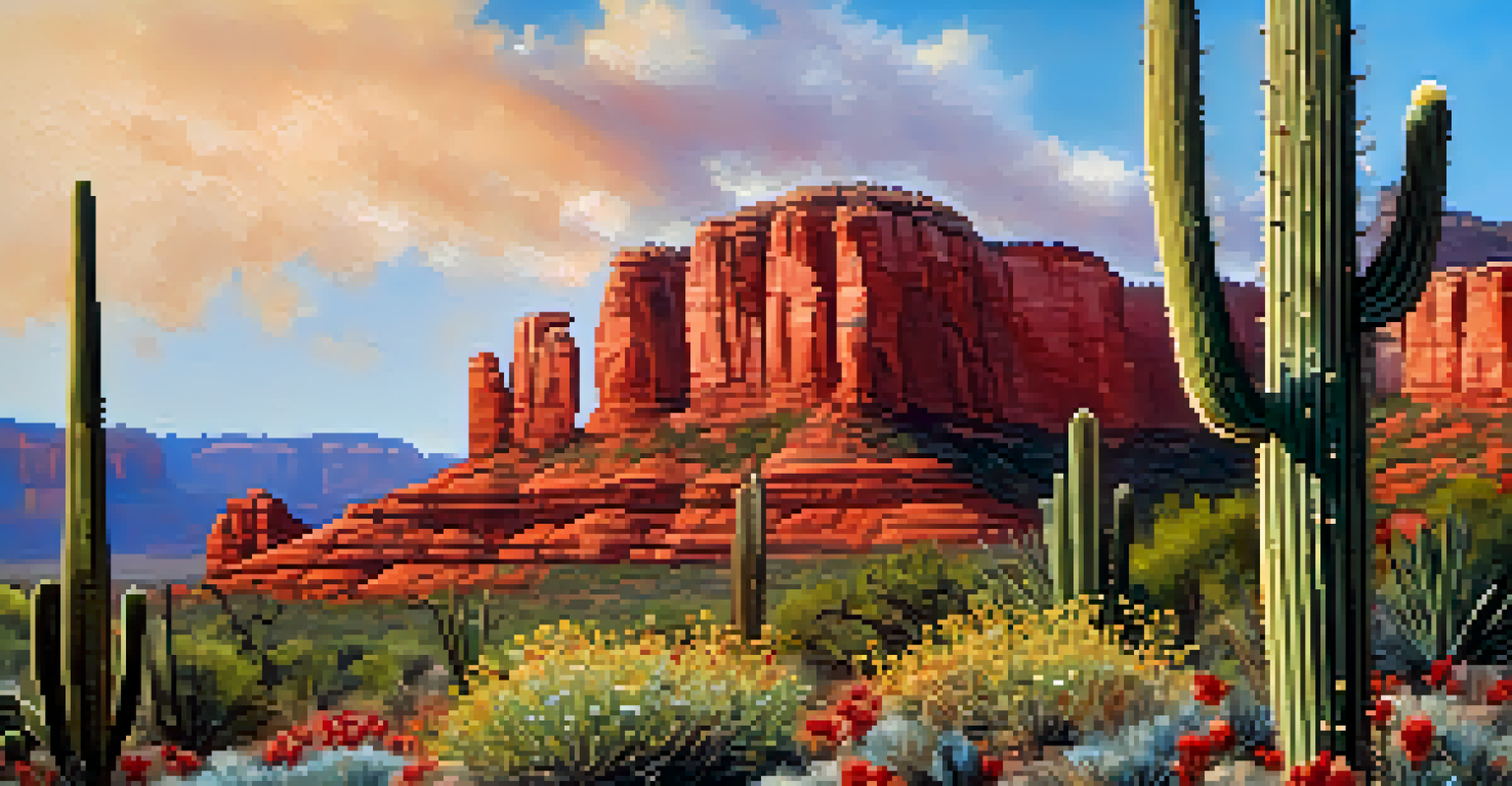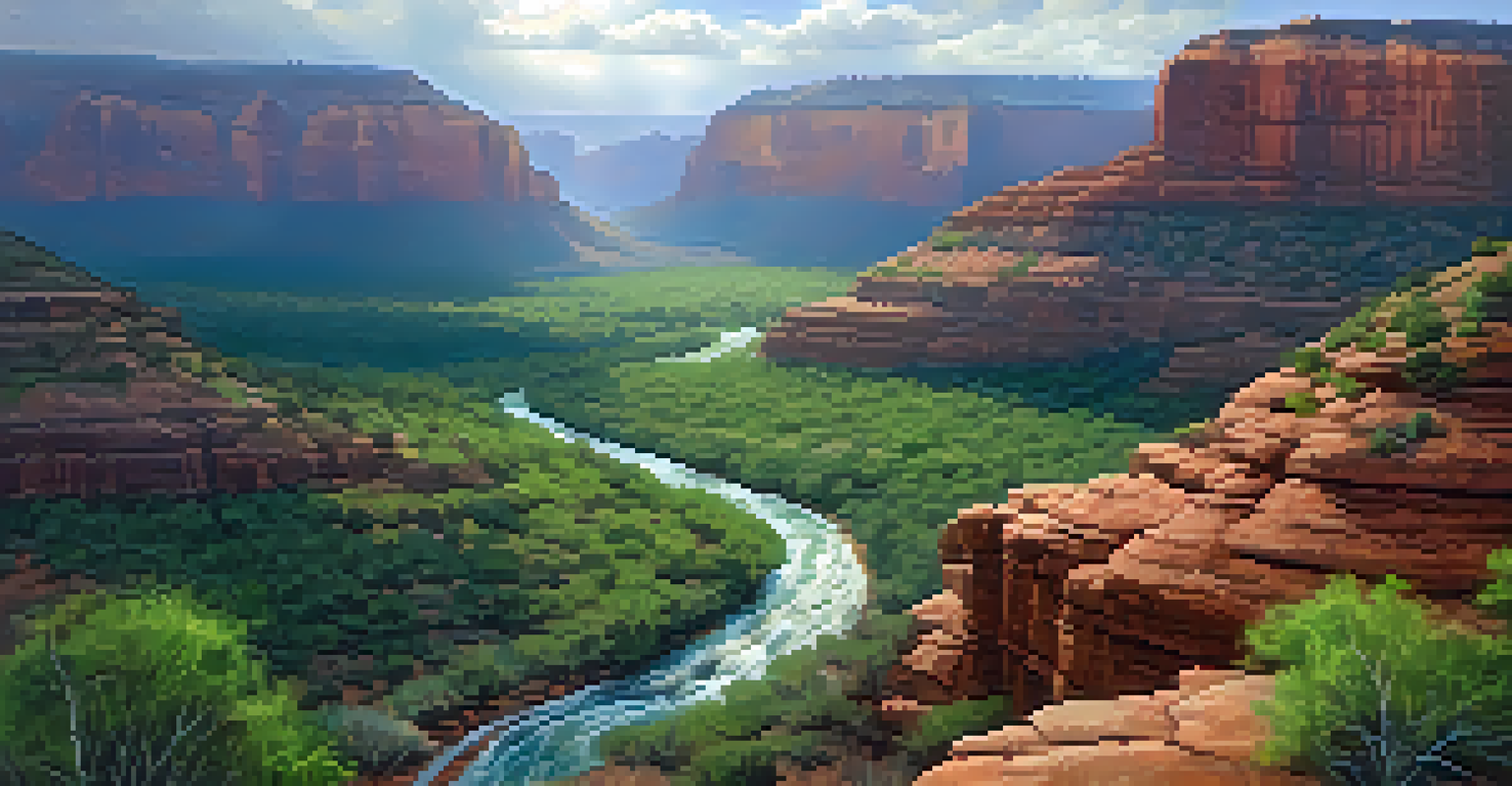Sedona's Rainfall: Patterns and Impacts on the Landscape

Overview of Sedona's Rainfall Patterns
Sedona, Arizona, is known for its stunning red rock formations, but its rainfall patterns are equally intriguing. The region experiences a semi-arid climate, with most precipitation occurring during the summer monsoon season. This typically runs from June to September, bringing intense but brief thunderstorms. Understanding these patterns is crucial for appreciating how they shape Sedona's landscape.
The rain is a blessing, a reminder that life is connected to nature in profound ways.
On average, Sedona receives about 20 inches of rainfall annually, but this can vary significantly from year to year. The summer months often see dramatic spikes in rainfall, while winters tend to be drier. This variability can influence everything from plant growth to water availability in the region's streams and rivers.
Moreover, the unique topography of Sedona affects how rainfall is distributed. Higher elevations typically receive more moisture than the valley floors, creating diverse ecosystems within a relatively small area. This intricate relationship between rainfall and geography plays a vital role in shaping Sedona's breathtaking scenery.
The Role of the Monsoon Season
The summer monsoon season is a defining feature of Sedona's climate, bringing much-needed moisture to the region. These storms often develop in the late afternoon, leading to spectacular displays of lightning and thunder. While they can be short-lived, they significantly contribute to the annual rainfall totals.

During the monsoon, the landscape comes alive as plants and wildlife respond to the increased moisture. Wildflowers bloom, and the vibrant colors of the desert come to life, offering a stark contrast to the arid backdrop. This seasonal transformation highlights the resilience of nature and its ability to thrive despite challenging conditions.
Monsoon Season Shapes Sedona's Ecosystem
The summer monsoon season brings crucial moisture that revitalizes Sedona's landscapes and supports diverse plant and animal life.
However, the monsoon season isn't without its challenges. Intense downpours can lead to flash flooding, particularly in canyons and low-lying areas. Residents and visitors must remain vigilant during these storms, as the rapid rise in water can be both dangerous and destructive.
Impacts on Vegetation and Wildlife
Sedona's rainfall patterns have a profound impact on local vegetation and wildlife. The availability of water during the monsoon season allows desert plants to flourish, leading to increased biodiversity. Species such as cacti, wildflowers, and shrubs all benefit from the seasonal rains, creating a lush environment that supports a variety of animals.
In the midst of chaos, there is a glimmer of beauty—a storm brings forth the vibrant colors of life.
Animals in Sedona have adapted to these rainfall patterns as well. Many species time their breeding cycles to coincide with the rainy season, ensuring that their young have access to abundant food sources. For example, birds often nest during the monsoon, taking advantage of the increased insect population resulting from the rains.
Conversely, prolonged dry spells can stress the ecosystem, leading to competition among species for limited resources. Drought conditions may force animals to migrate to find food and water, disrupting the delicate balance of the local ecosystem. This intricate interplay between rainfall and wildlife highlights the importance of understanding Sedona's climate.
Soil Erosion and Sedimentation Concerns
While rainfall is essential for Sedona's ecosystems, it can also lead to soil erosion and sedimentation issues. Intense rains, especially during the monsoon season, can wash away topsoil, reducing land productivity and altering landscapes. The red soil that Sedona is famous for is particularly vulnerable to erosion.
When rainwater rushes over bare soil, it carries sediment into local waterways, impacting water quality. This sedimentation can smother aquatic habitats and disrupt the balance of the ecosystem. Understanding these processes is critical for maintaining Sedona's natural beauty and ecological health.
Rainfall Affects Soil and Water Quality
Intense rainfall can lead to soil erosion and sedimentation, impacting local water quality and aquatic habitats.
To mitigate these effects, conservation efforts are underway to promote sustainable land management practices. These initiatives aim to protect soil health and prevent erosion, ensuring that Sedona's landscapes remain vibrant for future generations. Education and community involvement are key components of these efforts.
Water Resource Management in Sedona
Effective water resource management is crucial in Sedona, given its unique rainfall patterns. With the majority of precipitation occurring in a short period, it’s essential to capture and store this water efficiently. Local authorities and organizations are implementing strategies to optimize water usage and reduce waste.
Rainwater harvesting systems are becoming increasingly popular in Sedona, allowing residents to collect and store rainwater for later use. This practice not only conserves water but also helps reduce runoff and erosion. By utilizing this natural resource, the community is becoming more resilient to drought and water scarcity.
Moreover, education programs are encouraging residents to adopt water-wise landscaping practices. By choosing drought-resistant plants and implementing efficient irrigation systems, the community can thrive even in dry conditions. These initiatives underscore the importance of sustainable water management in preserving Sedona's natural landscape.
Cultural Significance of Rainfall in Sedona
Rainfall holds a deep cultural significance for the communities in Sedona, particularly among Indigenous peoples. Many local tribes view rain as a sacred gift, essential for life and sustenance. Traditional ceremonies and rituals often celebrate the arrival of rain, highlighting the profound connection between the land and its people.
For artists and writers, Sedona's rainfall patterns inspire creativity and reflection. The dramatic shifts in weather, from sunny days to sudden storms, mirror the emotional landscapes explored in their work. This interplay between nature and art fosters a unique cultural identity that is deeply rooted in the region's environment.
Climate Change Threatens Rainfall Patterns
As climate change alters weather patterns, Sedona faces potential challenges such as extreme weather events and water shortages.
Additionally, the landscape itself serves as a canvas for storytelling. The red rocks, shaped by centuries of erosion and rainfall, tell tales of resilience and transformation. This cultural narrative underscores the importance of preserving Sedona's natural environment, ensuring that future generations can experience its beauty and significance.
Future Outlook: Climate Change and Rainfall Trends
As climate change continues to impact weather patterns globally, Sedona's rainfall trends are also evolving. Scientists are studying how increased temperatures and shifting precipitation patterns may alter the region's climate. Understanding these changes is vital for planning and adapting to future environmental challenges.
Predictions suggest that Sedona may experience more extreme weather events, including heavier rainfall and prolonged dry spells. Such shifts could exacerbate issues like erosion and water shortages, making effective management even more critical. Local communities must be proactive in developing strategies to address these potential impacts.

By fostering resilience through sustainable practices and community engagement, Sedona can navigate the challenges posed by climate change. The collective effort to protect the landscape and its resources will ensure that Sedona remains a thriving environment for both its inhabitants and its visitors.